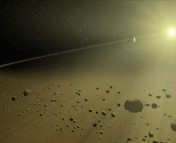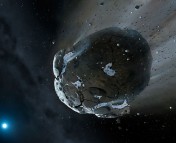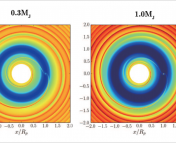Title: Hypervelocity Planets and Transits around Hypervelocity Stars
Authors: Idan Ginsburg, Abraham Loeb & Gary A. Wegner
First Author’s Institution: Dartmouth College, Hanover, NH
Introduction
As a child, I was disappointed to learn that “shooting stars” are not really stars flying through the sky. However, there are real shooting stars called hypervelocity stars (HVSs). These stars, with typical velocities of 1000 kilometers per second, are defined by their formation mechanism. When a binary star has a close encounter with the supermassive black hole at the center of our galaxy, the black hole can tidally rip the system apart, trapping one star in a tight orbit around the black hole and ejecting the other star with sometimes enough energy to escape the galaxy. For a more detailed discussion of the physics, see this theoretical Nature paper by Hills. To date, there are 16 known HVSs, although Hills predicted that there should be about 200 between us and the galactic center at any given time.
Science Motivation of the Paper
Ginsburg, Loeb and Wegner ask the question: if the precursors to HVSs have planets, what happens to those planets when the black hole rips the binary system apart and ejects one star at thousands of kilometers per second? What are the odds that a planet around the soon-to-be HVS stays bound to the star, affording the possible detection of planets transiting HVSs? Similarly, what are the odds that the planet gets stripped from the system and ejected, and how fast would it be?
Methods
To answer these questions, the authors simulated binary systems with two or four planets approaching the black hole. Their initial setup is as follows: Each star in the binary system is three-solar masses, which is typical of HVSs. The stars are separated by 0.05 – 0.5 AU. Each star has one (or in the second set of simulations, two) test-particle planets orbiting at 0.02 (and 0.03) AU, which corresponds to the orbital positions of very hot Jupiters. The system starts 2000 AU from a 4 million-solar mass black hole. The distance of closest approach to the black hole (the “impact parameter”) varies from 5 – 35 AU, enabling the formation of an HVS.
Results
The authors consider four possible fates for a planet around an HVS: (1) The planet can be ejected as a hypervelocity planet (HVP), dynamically free from the binary system, (2) the planet can remain bound to its host HVS, (3) the planet can collide and merge with a star, or (4) the planet can be captured in an orbit around the black hole. Each of these four possibilities is discussed below.
HVPs
The authors find that HVPs form in 30-40% of systems with two planets and in 70-80% of systems with four planets. The average velocity of the HVS is about 1500 km/s, whereas the average velocity of the HVP was about 4000 km/s. A more detailed breakdown by velocity is shown in figure 1.
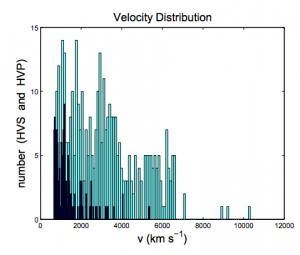
Figure 1. A histogram showing the number of hypervelocity stars (black) and hypervelocity planets (light blue) as a function of velocity. In these simulations, the initial separation between the binary stars was 0.2 AU. From Ginsburg, Loeb & Wegner.
HVSs with Planets
After the interaction with the black hole, about 1% of planets remain bound to an HVS. The authors calculate the probability that these planets would transit their host star. Although transits are typically very rare, the constraint that these planets are very close to their star (0.02 AU) increases the transit probability dramatically, to about 90%, as shown in figure 2.
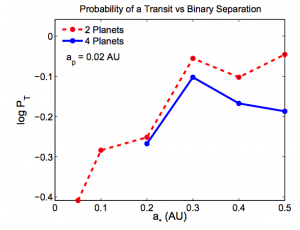
Figure 2. The y-axis shows the logarithm of the transit probability of a planet 0.02 AU from an HVS. (Where log(P)=0, the probability is 100%.) The x-axis shows the initial separation between the HVS and its former companion. From Ginsberg, Loeb & Wegner.
The transit of a hot Jupiter creates a drop in stellar brightness by about 1%. However, before we point our telescopes to look for these planets, we should remember that this probability is conditioned on (1) the existence of a hot Jupiter orbiting each star in the binary system, (2) the 1% chance that an HVS has a bound planet, and (3) the assumption that we can see a transit of an HVS (HVSs are very faint; we’ve only found 16 of them).
Collisions
The encounter with the black hole rarely (0.1% of cases for two-planet systems, 1% for four-planet systems) causes a planet to collide with its host star. If the collision happens at an energy lower than the gravitational potential at the surface of the star, the planet will eventually merge with the star, potentially enriching the metal content at its surface. However, the authors note that a metal-enhanced star would lose 90% of the metallicity enhancement in just six million years. Thus, if a metal-enriched HVS were discovered, we could conclude that it had undergone a recent collision.
Orbital Capture by the Black Hole
The most common fate for the planets is that they are captured in a highly eccentric orbit around the black hole. This is much like the fate of the former companion star to an HVS, although the planets follow their own orbits that are independent of the remaining star. The probability that one planet in any run of the simulation would be captured in this manner was greater than 60%. The authors note that, although unlikely, a planet orbiting the black hole could eclipse the stars that also orbit the black hole.
Conclusion
In summary, the authors find four possible fates for a planet around an HVS. In the simulations, 0.1 – 1% of planets collide with a star, 1% remain bound to the HVS, more than 60% orbit the black hole, the rest are ejected as HVPs. Although there are very few observed HVSs, there should be many more out there, and if the authors’ calculations are corrected, there should be some HVPs too. If we lived near the galactic center, perhaps our sky would be filled with real shooting stars, and with shooting planets too.

